To maximize arm development, doing dumbbell exercises for triceps is a must.
While heavy barbell pressing builds the foundation, triceps exercises with dumbbells allow you to emphasize each head of the triceps individually, ensuring proportional growth.
In this article, you’ll learn the anatomy and mechanics of your triceps, why dumbbell exercises for the triceps are so effective, the 10 best triceps dumbbell exercises for size and strength, a science-based triceps workout with dumbbells, and more.
Want to know exactly how you should train to reach your fitness goals? Take our free 60-second training quiz and find out now.
Key Takeaways
- Dumbbell triceps exercises are excellent for gaining balanced triceps size and strength.
- They allow you to train unilaterally, through a greater range of motion, and with more variety than barbells or machines.
- The best dumbbell triceps exercises include presses, skullcrushers, overhead extensions, and kickbacks. Each of these exercises targets a different part of the triceps, ensuring you develop all-around size.
- To get the most out of your dumbbell triceps workouts, train close to failure, strive to gain strength over time, and include a mix of compound and isolation movements in your routine.
- For faster results, consider using a high-quality protein powder to help you reach your daily protein target, creatine to support recovery and muscle growth, and a pre-workout to enhance energy, focus, and performance.
Triceps Anatomy
The triceps brachii, or “triceps,” is the muscle located on the back of the upper arm, between the shoulder and elbow.
It has three sections or “heads:”
- Lateral head: The lateral head is the strongest head of the triceps. It’s on the outside of your upper arm, so it’s the most visible when your arms are at your sides. Its main function is straightening the elbow.
- Medial head: The medial head of the triceps is hidden deep in your arm and primarily straightens the elbow.
- Long head: The long head is the largest part of the triceps. It runs along the inside of your arm and has three functions: it straightens the elbow and plays smaller roles in shoulder extension (bringing your arms from overhead to your sides by moving in an arc in front of you) and shoulder adduction (bringing your arms toward your body’s midline).
Here’s how the triceps looks:
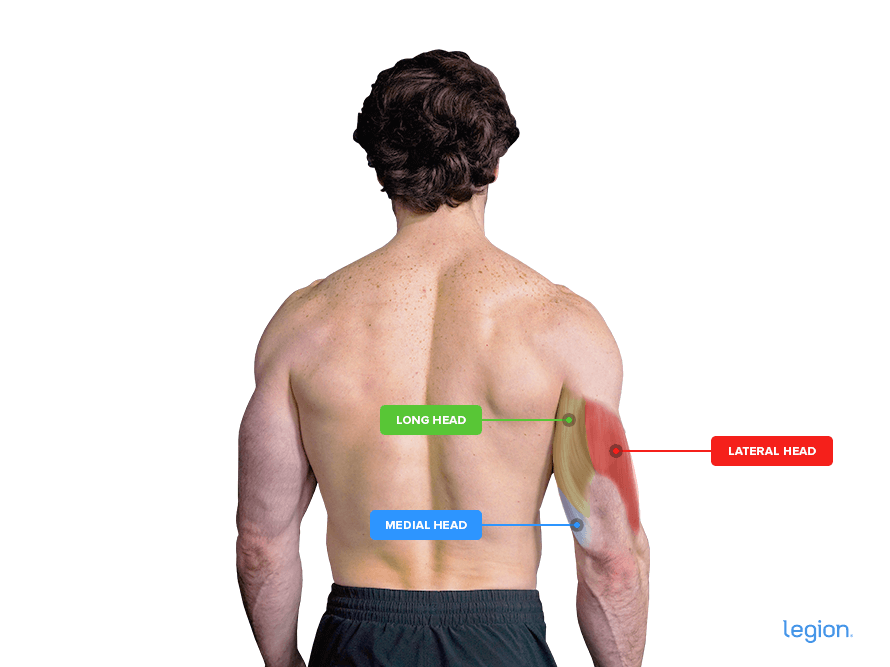
The Best Dumbbell Triceps Exercises
Here are the best triceps exercises with dumbbells for all-around triceps development and strength.
1. Flat Dumbbell Bench Press
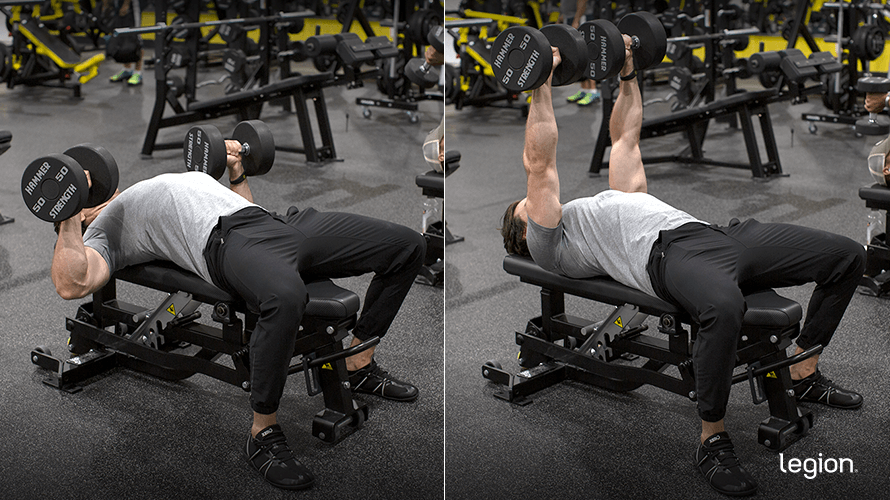
The flat dumbbell bench press is one of the single best exercises for building several major muscle groups in your upper body, including your triceps. It allows you to lift heavy weights safely and progress regularly, which is ideal for gaining size and strength.
How to:
- While sitting on a flat bench, hold a dumbbell in each hand and rest them on your thighs.
- Lie back and hoist the dumbbells so you’re holding them on either side of your chest by nudging them with your thighs.
- With your palms facing your feet and your elbows flared 45 degrees from your torso, press the dumbbells straight over your chest until your arms are straight and your elbows are locked.
- Reverse the movement and return to the starting position.
2. Neutral-Grip Dumbbell Bench Press
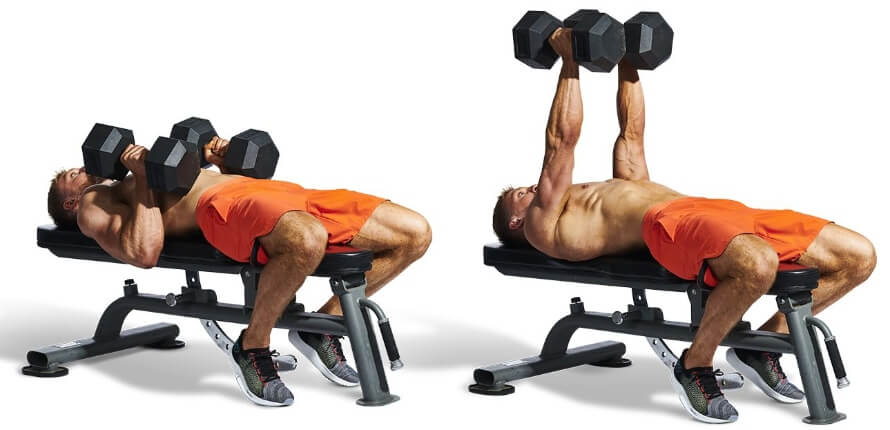
In the neutral-grip dumbbell bench press, you hold the dumbbells with your palms facing each other and tuck your elbows close to your sides, which increases how much the triceps contribute to the press.
How to:
- While sitting on a flat bench, hold a dumbbell in each hand and rest them on your thighs.
- Lie back and hoist the dumbbells so you’re holding them on either side of your chest by nudging them with your thighs.
- With your palms facing each other and your elbows tucked 4-to-6 inches from your sides, press the dumbbells straight over your chest until your arms are straight and your elbows are locked.
- Reverse the movement and return to the starting position.
3. Dumbbell Floor Press
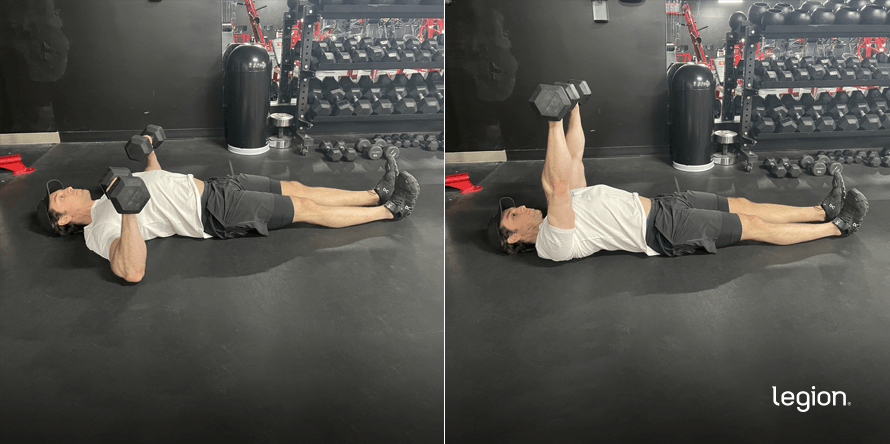
By limiting the range of motion, the dumbbell floor press emphasizes your triceps instead of your pecs. This helps you improve your “lockout strength” on pressing exercises and adds mass to your upper arms.
How to:
- While sitting on the floor, hold a dumbbell in each hand and rest them on your thighs.
- Lie back and hoist the dumbbells so you’re holding them on either side of your chest, and your triceps are in contact with the floor.
- With your palms facing your feet, press the dumbbells straight over your chest until your arms are straight and your elbows are locked.
- Reverse the movement and return to the starting position.
4. Dumbbell JM Press
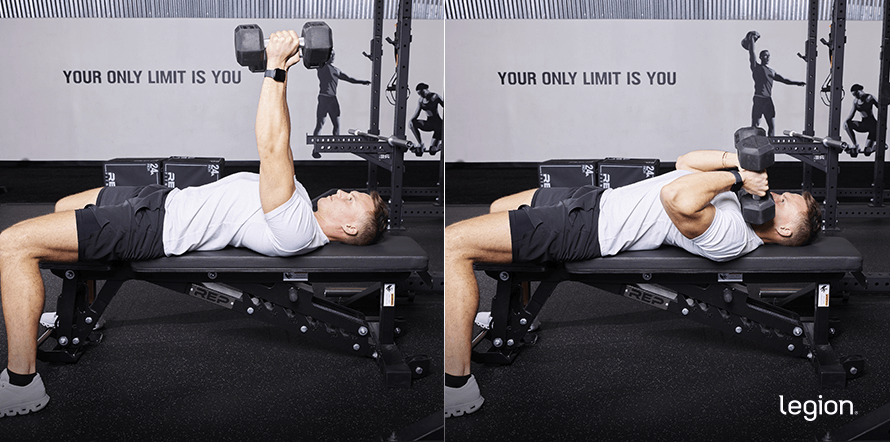
The dumbbell JM press is a close-grip bench press and skullcrusher hybrid that’s particularly effective for strengthening the triceps, making it a popular choice among powerlifters and bodybuilders looking to develop explosive pressing strength.
How to:
- While lying on a flat bench, hold a pair of dumbbells over your chest with your palms facing each other.
- Bend your elbows and lower the dumbbells to either side of your neck.
- Straighten your arms and return to the starting position.
5. Dumbbell Skullcrusher
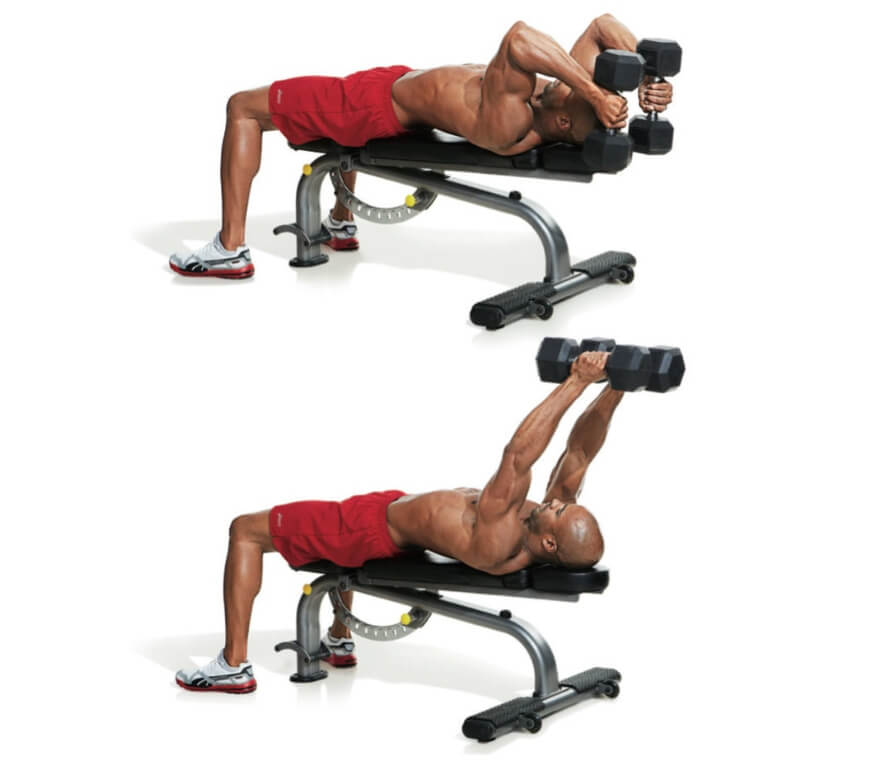
The dumbbell skull crusher is a great exercise for training the medial and lateral heads of the triceps, ensuring you have defined, proportional upper arms.
How to:
- Lie on a flat bench with a pair of dumbbells pressed over your chest and your palms facing each other.
- Bend your elbows and lower the dumbbells until they are on either side of your head.
- Straighten your arms and return to the starting position.
6. Dumbbell Overhead Triceps Extension
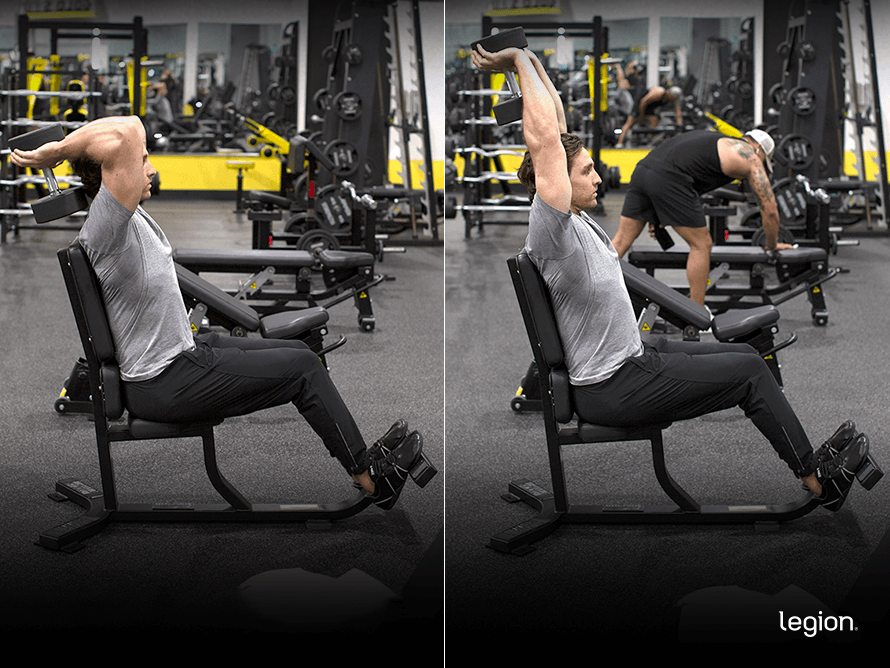
The dumbbell overhead triceps extension is a top dumbbell exercise for the triceps because it fully stretches the triceps, which is vital for maximizing muscle growth.
How to:
- Sit up straight on a bench.
- Grip one end of a dumbbell and lift it overhead.
- Lower the weight until it’s behind your head by bending at the elbow, then extend your elbows to return to the starting position.
7. Dumbbell Deficit Push-up
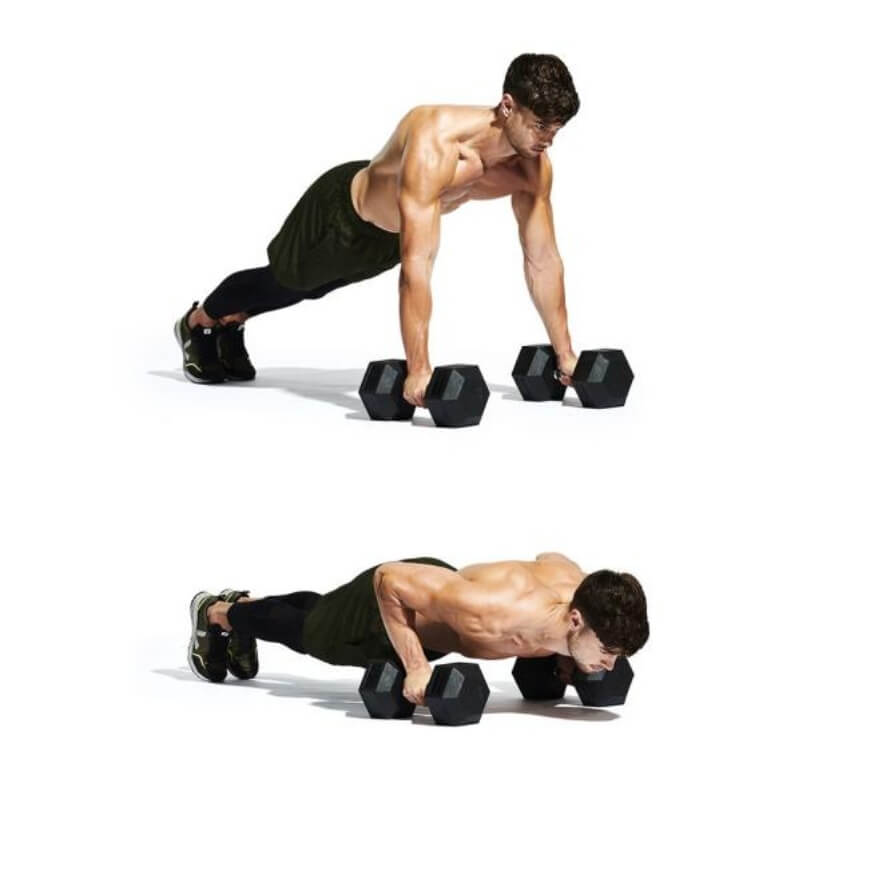
The dumbbell deficit push-up increases the range of motion compared to a regular push-up, thereby stretching the triceps more deeply, making it an excellent choice for building upper-arm size.
How to:
- Place a pair of dumbbells on the floor shoulder-width apart.
- Get on all fours and grab the dumbbell handles.
- Extend your legs behind you so you’re in a plank position, and your body forms a straight line from your head to your feet.
- Lower your chest to the floor, then push your body up and return to the starting position.
8. Tate Press
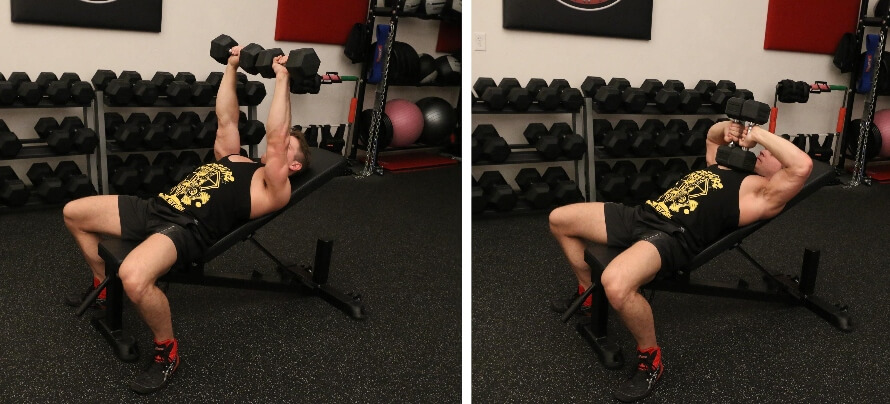
The Tate press is a unique triceps exercise that emphasizes the lateral head triceps, which is important for proportional upper-arm development.
How to:
- While lying on an incline bench, hold a pair of dumbbells over your chest with the inner ends of the dumbbells touching and your elbows flared out to the sides.
- Bend your elbows and bring the inner ends of the dumbbells to your chest.
- Straighten your elbows and return to the starting position.
9. Dumbbell Pullover
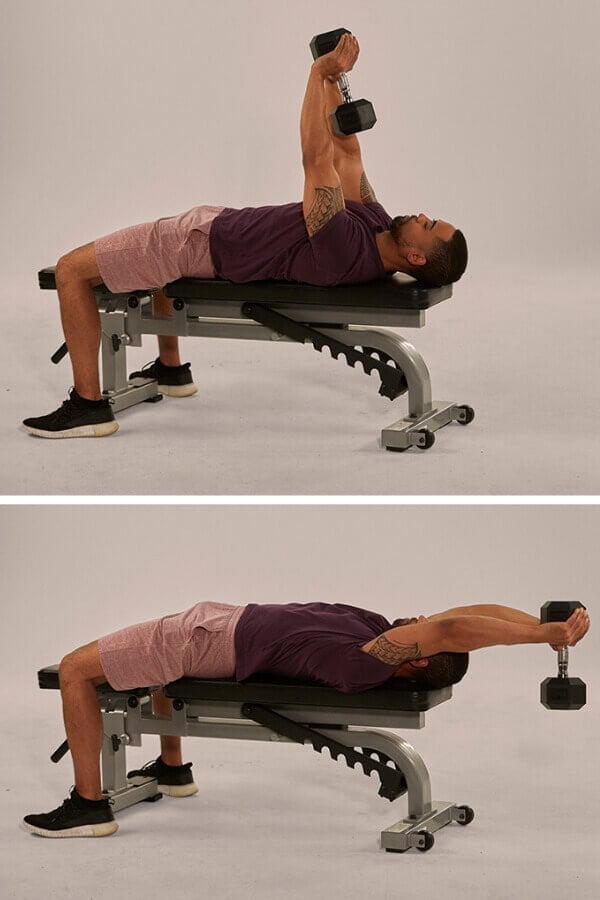
The dumbbell pullover trains shoulder extension, which is one of the long head’s primary functions. As such, it’s an excellent exercise for adding mass to your upper arms.
How to:
- While lying on a flat bench with your head as close to the end as possible, hold a dumbbell by one end with both hands over your chest.
- While keeping your elbows bent slightly, lower the dumbbell in an arc over your head until your biceps are next to your ears.
- Reverse the movement and return to the starting position.
10. Dumbbell Triceps Kickback
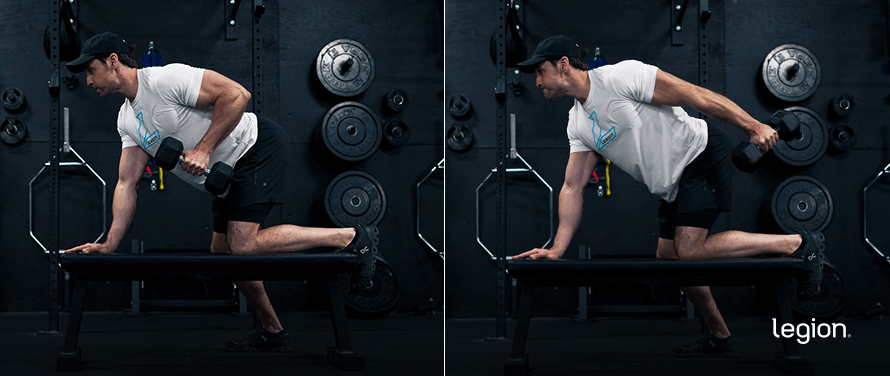
Performing the dumbbell triceps kickback with your elbows slightly behind your body targets the long head of the triceps, which is important because the long head has the most significant impact on upper-arm size.
How to:
- Hold a dumbbell in your right hand.
- Plant your left knee and arm firmly on a bench and your right foot on the floor a foot or two from the bench. Position your right elbow slightly behind your torso, but bend it at about 90 degrees so the weight hangs toward the floor.
- Push the weight toward your hip by straightening your elbow.
- Reverse the movement and return to the starting position.
The Benefits of Doing Dumbbell Exercises for Triceps
1. They allow you to train unilaterally.
Using dumbbells allows you to train your triceps unilaterally (a single arm at a time), which has several benefits:
- It may allow you to lift more total weight than when you train bilaterally (both sides of the body simultaneously), potentially helping you gain more muscle over time.
- It helps you develop a greater mind-muscle connection because you only need to focus on one side of your body at a time.
- It helps you find and fix muscle and strength imbalances by forcing both sides of your body to lift the same amount of weight.
- It may improve your athletic performance more than bilateral training.
2. They allow you to train through a longer range of motion.
A barbell can limit your range of motion on some triceps exercises. For example, in the close-grip barbell bench press, you must stop each rep when the bar touches your torso, even though you could comfortably lower the weight a few more inches.
Dumbbell triceps exercises sidestep this issue because there’s no bar to hit your body, allowing you to train your muscles through a full range of motion and maximize muscle and strength gain.
3. They’re versatile.
Because dumbbells are more maneuverable than barbells, dumbbell exercises for triceps allow you to train through different ranges of motion, at varying angles, and using a range of grip orientations, which likely produces more balanced and complete muscle growth than taking a less varied approach to training.
The Best Triceps Workout with Dumbbells

How to Optimize Your Triceps Workouts with Dumbbells
1. End every set 1-to-2 reps shy of muscle failure.
To maximize muscle and strength gains, you must take most of your sets within a rep or two of muscle failure.
Ask yourself at the end of each set, “If I had to, how many more reps could I have gotten with good form?” If the answer is more than two, increase the weight or reps to make your next set more challenging.
2. Once you hit the top of your rep range for one set, increase the weight.
If your triceps workout with dumbbells calls for 4-to-6 reps of the neutral-grip dumbbell bench press and you get 6 reps for a set, add 10 pounds to your next set.
If you manage 3 or fewer reps with the new weight, reduce the weight by 5 pounds to ensure you stay in the 4-to-6 rep range.
Follow this pattern of trying to add reps or weight to every exercise in every workout.
3. Take the right supplements.
The best supplements for maximizing triceps development are:
- Protein powder: Protein powder, such as whey or casein, provides your body with the nutrients needed to build muscle tissue and recover from workouts. For a clean and delicious protein powder, try Whey+ or Casein+.
- Creatine: Creatine boosts muscle and strength gain, improves anaerobic endurance, and reduces muscle damage and soreness from your workouts. For a natural source of creatine, try our creatine monohydrate, creatine gummies, or Recharge.
- Pre-workout: A high-quality pre-workout enhances energy, mood, and focus, increases strength and endurance, and reduces fatigue. For a top-tier pre-workout containing clinically effective doses of 6 science-backed ingredients, try Pulse with caffeine or without.
(If you’d like even more specific advice about which supplements you should take to reach your health and fitness goals, take the Legion Supplement Finder Quiz, and in less than a minute, you’ll know exactly what supplements are right for you.)
Triceps Dumbbell Exercises: FAQs
1. Can I grow my triceps using only dumbbell exercises for triceps?
Yes.
The triceps exercises above allow you to lift heavy weights safely and make consistent progress, so they’re ideal for gaining muscle.
2. How often should I do a triceps workout with dumbbells?
If your existing strength training program already includes a lot of pressing exercises, incorporating a dedicated triceps workout with dumbbells once weekly is sufficient for triceps growth.
And if you don’t follow a strength training program but want to, check out my fitness books for men and women, Bigger Leaner Stronger or Thinner Leaner Stronger.
(Or if you aren’t sure if Bigger Leaner Stronger or Thinner Leaner Stronger is right for you, take the Legion Strength Training Quiz. In less than a minute, you’ll know the perfect strength training program for you. Click here to check it out.)
3. How do I know which dumbbell triceps exercises to include in my triceps workouts with dumbbells?
There are no set rules for structuring a triceps workout with dumbbells. However, applying the following guidelines will help ensure your triceps develop proportionally and you build balanced upper-body strength:
- Begin your workout with a compound pressing exercise that trains all three heads of your triceps and allows you to lift heavy weights safely.
- Do 2-to-3 isolation dumbbell exercises for the triceps that place your upper arm in different positions relative to your torso. For example, do one exercise that puts your upper arms overhead, one that positions them in front and perpendicular to your torso, and another with your arms by your sides or slightly behind.
Scientific References +
- Landin, Dennis, et al. “Functions of the Triceps Brachii in Humans: A Review.” Journal of Clinical Medicine Research, vol. 10, no. 4, 2018, pp. 290–293, https://doi.org/10.14740/jocmr3340w.
- Tiwana, Manpreet S, et al. “Anatomy, Shoulder and Upper Limb, Triceps Muscle.” Nih.gov, StatPearls Publishing, 6 Aug. 2021, www.ncbi.nlm.nih.gov/books/NBK536996/#:~:text=With%20the%20arm%20adducted%2C%20the.
- Landin, Dennis, and Melissa Thompson. “The Shoulder Extension Function of the Triceps Brachii.” Journal of Electromyography and Kinesiology, vol. 21, no. 1, Feb. 2011, pp. 161–165, https://doi.org/10.1016/j.jelekin.2010.09.005. Accessed 13 Nov. 2020.
- Oranchuk, Dustin J., et al. “Isometric Training and Long-Term Adaptations: Effects of Muscle Length, Intensity, and Intent: A Systematic Review.” Scandinavian Journal of Medicine & Science in Sports, vol. 29, no. 4, 13 Jan. 2019, pp. 484–503, https://doi.org/10.1111/sms.13375.
- Kholinne, Erica, et al. “The Different Role of Each Head of the Triceps Brachii Muscle in Elbow Extension.” Acta Orthopaedica et Traumatologica Turcica, vol. 52, no. 3, 1 May 2018, pp. 201–205, www.ncbi.nlm.nih.gov/pmc/articles/PMC6136322/, https://doi.org/10.1016/j.aott.2018.02.005. Accessed 3 Sept. 2020.
- Jakobi, Jennifer M., and Philip D. Chilibeck. “Bilateral and Unilateral Contractions: Possible Differences in Maximal Voluntary Force.” Canadian Journal of Applied Physiology, vol. 26, no. 1, Feb. 2001, pp. 12–33, https://doi.org/10.1139/h01-002.
- Liao, Kai-Fang , et al. Review Paper Effects of Unilateral vs. Bilateral Resistance Training Interventions on Measures of Strength, Jump, Linear and Change of Direction Speed: A Systematic Review and Meta-Analysis. Mar. 2022, https://doi.org/10.5114/biolsport.2022.107024.
- Costa, Bruna Daniella de Vasconcelos, et al. “Does Performing Different Resistance Exercises for the Same Muscle Group Induce Non-Homogeneous Hypertrophy?” International Journal of Sports Medicine, vol. 42, no. 09, 13 Jan. 2021, pp. 803–811, https://doi.org/10.1055/a-1308-3674.
- Stokes, Tanner, et al. “Recent Perspectives Regarding the Role of Dietary Protein for the Promotion of Muscle Hypertrophy with Resistance Exercise Training.” Nutrients, vol. 10, no. 2, 7 Feb. 2018, p. 180, www.mdpi.com/2072-6643/10/2/180/pdf, https://doi.org/10.3390/nu10020180.
- Jd, Branch. “Effect of Creatine Supplementation on Body Composition and Performance: A Meta-Analysis.” International Journal of Sport Nutrition and Exercise Metabolism, 1 June 2003, pubmed.ncbi.nlm.nih.gov/12945830/.
- Eckerson, Joan M., et al. “Effect of Creatine Phosphate Supplementation on Anaerobic Working Capacity and Body Weight after Two and Six Days of Loading in Men and Women.” The Journal of Strength and Conditioning Research, vol. 19, no. 4, 2005, p. 756, https://doi.org/10.1519/r-16924.1.
- Bassit, Reinaldo Abunasser, et al. “Effect of Short-Term Creatine Supplementation on Markers of Skeletal Muscle Damage after Strenuous Contractile Activity.” European Journal of Applied Physiology, vol. 108, no. 5, 3 Dec. 2009, pp. 945–955, https://doi.org/10.1007/s00421-009-1305-1.










